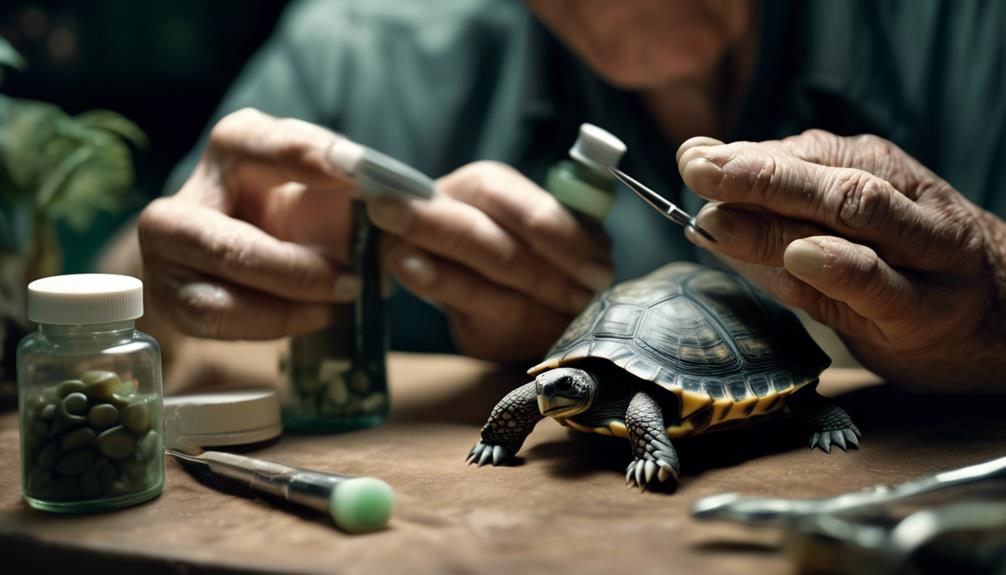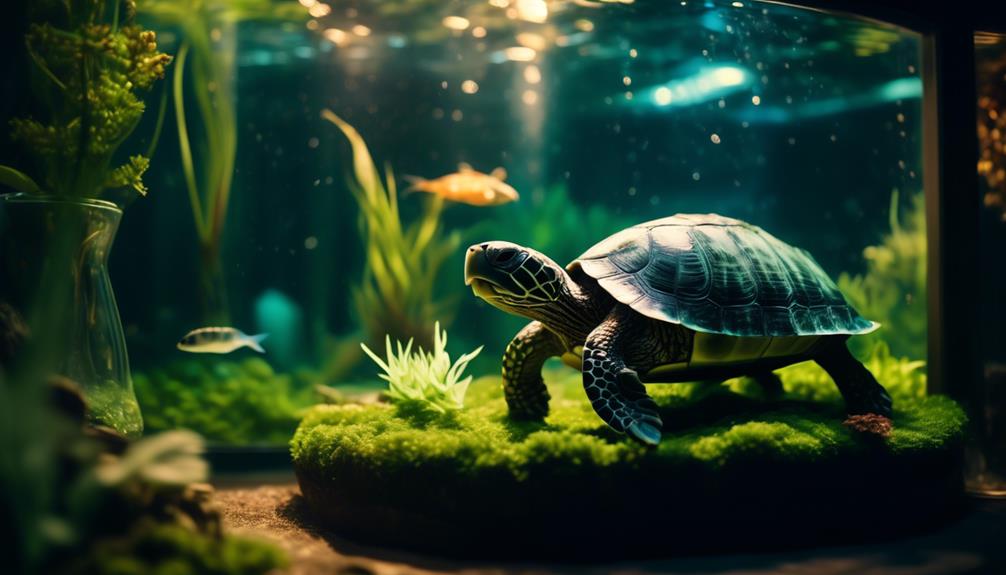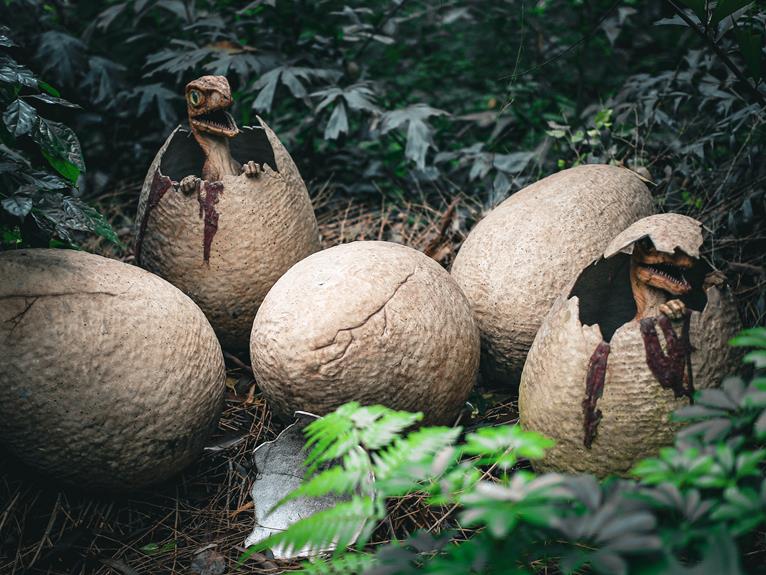Are you tired of the mundane and meaningless tasks of everyday life? Looking for a way to inject some excitement and purpose into your existence?
Well, look no further! We present to you the ultimate challenge: mastering the art of Reeve's turtle care.
Now, you might be wondering, what's so special about taking care of turtles? What could possibly be thrilling about it? Ah, my friend, that is the beauty of this journey.
As we embark on this adventure together, we will uncover the hidden depths of turtle care, unraveling its secrets and discovering the profound satisfaction that comes from nurturing these incredible creatures.
So, are you ready to dive into the world of Reeve's turtle care and unlock a sense of purpose you never knew existed?
Key Takeaways
- Reeves turtles require both aquatic and terrestrial environments in their enclosure.
- It is important to provide ample space and water for Reeves turtles, with at least 10 gallons of water per inch of the turtle's expected adult length.
- Regular exposure to high-quality UVB lighting is necessary for Reeves turtles, with recommended UVB bulbs and placement close to heat lamps.
- Reeves turtles have specific temperature and water condition requirements, including maintaining a basking temperature of 95°F, water temperature between 70-80°F, and using appropriate heat lamps for basking.
Enclosure and Lighting

To properly care for Reeves turtles, it's crucial to provide an enclosure that meets their unique aquatic and terrestrial needs, as well as ensure they've access to high-quality lighting. When designing the enclosure, consider using Waterland tubs for indoor enclosures or opting for outdoor housing with a fenced-in pond for ample space.
For lighting, it's recommended to use UVB bulbs like Zoo Med Reptisun T5 HO 5.0 or Arcadia Forest 6%. Position the UVB bulb half the length of the enclosure and close to the heat lamps. Regularly replace the UVB bulb every 12 months for optimal performance. Additional LED or T5 HO 6500K daylight lamps can also be used for better illumination.
Temperature and Water Conditions
Maintaining proper temperature and water conditions is essential for the well-being of Reeves turtles. As caretakers, it's our responsibility to provide an environment that meets their specific needs.
Here are some important considerations for water temperature control and basking temperature requirements:
- Water temperature: Keep the water temperature between 70-80°F. This range mimics their natural habitat and ensures their comfort and overall health.
- Basking temperature: Maintain a basking temperature of 95°F in the air. This allows the turtles to regulate their body temperature and aids in digestion and overall well-being.
- Halogen flood heat lamps: Use halogen flood heat lamps positioned over the land portion of the enclosure for basking. These lamps provide the necessary warmth and light for the turtles to bask comfortably.
- Avoid ceramic heat emitters, red bulbs, or blue bulbs: These heat sources may disrupt the turtles' basking behavior and can cause stress or discomfort.
Substrate and Decor

When creating a suitable habitat for Reeves turtles, it is important to consider the appropriate substrate and decor to provide a comfortable and enriching environment. In the land portion of the enclosure, we recommend using several inches of semi-moist, sandy soil, such as Zoo Med Reptisoil or a mix of clean topsoil and play sand. For the aquatic portion, sand and crushed coral can be used as substrate, but avoid using pebbles or gravel. It is crucial to clean the substrate regularly with a siphon or during water changes to maintain cleanliness. To enhance the habitat, incorporate live or artificial aquatic and terrestrial plants. Additionally, provide hiding spots for the turtle, including underwater hiding areas. Decorate the enclosure with mopani wood, hollow logs, and terracotta pots to create a natural and stimulating environment for your Reeves turtle.
| Substrate and Decor |
|---|
| Land portion: Several inches of semi-moist, sandy soil |
| Aquatic portion: Sand and crushed coral |
| Cleaning: Regularly clean substrate with a siphon or during water changes |
| Aquatic plants: Incorporate live or artificial aquatic plants |
| Hiding spots: Provide underwater hiding areas and additional decor |
Reeves Turtle Diet
After creating a suitable habitat with the appropriate substrate and decor, it's essential to understand the dietary needs of Reeves turtles. Feeding these turtles requires a proper schedule and a balanced mixture of protein and vegetable foods.
Here is a recommended feeding schedule and a list of protein foods for Reeves turtles:
- Reeves turtle feeding schedule:
- Turtles younger than 6 months: Protein food or pellets daily, Vegetable food daily.
- Turtles between 6-12 months: Protein food or pellets every other day, Vegetable food daily.
- Turtles older than 1 year: Protein food or pellets 2-3 times a week, Vegetable food daily.
- Recommended protein foods for Reeves turtles:
- Crickets
- Earthworms
- Dubias
- Freeze-dried shrimp/krill
- Frozen bloodworms
Miscellaneous Tips

To ensure the well-being of your Reeves turtle, there are several miscellaneous tips that you should keep in mind for their care. Underwater safety is crucial for these turtles, as they require a significant portion of their enclosure to be water. Hatchlings need shallow water, while adults can handle deeper water. Providing underwater stopover objects, such as rocks or floating platforms, is essential to prevent drowning. Another important aspect of turtle care is maintaining clean water. Using a canister-style water filtration system that can handle 2-3 times the amount of water in the enclosure is recommended. Additionally, regular water changes of approximately 30% every 1-2 weeks are necessary for optimal water quality. By following these tips, you can ensure a safe and healthy environment for your Reeves turtle.
| Underwater Safety | Water Filtration Systems |
|---|---|
| – Hatchlings need shallow water | – Canister-style filter |
| – Provide stopover objects | – Handles 2-3x water volume |
| – Prevent drowning | – Regular water changes |
| – Adults can handle deeper water | – Optimal water quality |
Frequently Asked Questions
How Often Should I Trim My Reeves Turtle's Nails?
We recommend trimming your Reeves turtle's nails every 4-6 weeks to prevent overgrowth. Use a specialized reptile nail clipper and be careful not to cut into the quick. If unsure, consult a veterinarian for best practices.
Can Reeves Turtles Be Housed With Other Turtle Species?
Reeves turtles should not be housed with other turtle species due to potential aggression and disease transmission. It is crucial to prioritize the care requirements of Reeves turtles, ensuring they have appropriate housing compatibility for optimal health and well-being.
Are Reeves Turtles Prone to Any Specific Health Issues or Diseases?
Reeves turtles are prone to common health issues such as shell infections, respiratory infections, and vitamin deficiencies. To prevent diseases, maintain proper temperature and water conditions, provide a balanced diet, and ensure a clean environment with regular water changes and substrate cleaning.
How Long Do Reeves Turtles Typically Live in Captivity?
Reeves turtles typically live around 20-30 years in captivity with proper care. To ensure their longevity, provide a well-balanced diet, suitable enclosure, proper lighting, and maintain optimal temperature and water conditions.
Can Reeves Turtles Be Kept in a Communal Enclosure or Do They Prefer to Be Solitary?
Reeves turtles can be kept in a communal enclosure, but they also have the preference for solitary living. While communal enclosures offer social interaction, some individuals may display aggressive behavior.
Conclusion
Are you ready to become a Reeve's turtle care expert? With our comprehensive guide, you now have all the essential information and tips to ensure the well-being and happiness of your beloved turtles.
From enclosure and lighting requirements to temperature and water conditions, substrate and decor choices, and even the perfect diet and feeding schedule, we've got you covered.
So, why wait? Start your journey towards mastering the art of Reeve's turtle care today and witness the incredible transformation in your turtles' health and happiness.


